Isabella Bradford's Blog, page 22
January 4, 2018
From the Archives: Snowball Fight, 1896
Susan reporting,
With much of the American east coast suffering from snow, high winds, and plunging temperatures, it seems only appropriate to pull this video from the deep-freeze (oof!) of our archives to share again.
This very short – under a minute – silent black-and-white film was shot in 1896. Directed and produced by pioneer French filmmaker Louis Lumière, the film is called Bataille de boules de neige, or Snowball Fight. This snowball battle (with an unfortunate cyclist in the middle) was filmed on a street in Lyon, France. I love how the combatants are both men and women, and despite their huge leg-o-mutton sleeves, these ladies can pitch a mean snowball.
If you're received this video via email, you may be seeing an empty space or black box where the video should be. Go here to view the video.
Published on January 04, 2018 21:00
January 3, 2018
Fashions for January 1806
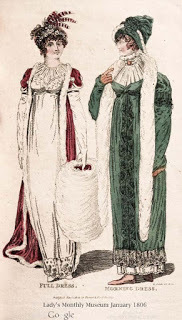 January 1806 Full & Walking Dress
Loretta reports:
January 1806 Full & Walking Dress
Loretta reports:It’s a New Year, in which I’ll offer a new cycle of monthly fashion prints, starting with the first decade of the 1800s.
This one is from the Lady’s Monthly Museum, one of several popular ladies’ magazines of the 19th century. Many of these included, along with fiction, poetry, and non-fiction of various kinds, illustrations and descriptions of the hot new fashion of the month.
When it comes to the earlier decades of the 1800s, I like to do readers a favor and send them to Candice Hern’s website .
There you will find definitions, often with illustrations, of the various fashion terms , as well discover what " full dress " means. Her article about " half dress " may help explain why the print calls the dress on the right a Morning Dress, while the description calls it a Walking Dress.
While you’re at the site, you might want to peruse her collection of Regency artifacts.
~~~
Walking Dress.A Green Velvet Hat, turned up in Front, and edged with White Swandown, ornamented with a Green Velvet Flower. A Pelisse of Green Velvet, with Bishop’s Sleeves, trimmed with Black Lace. Habit Shirt of clear Muslin; Swandown Tippet. Buff Boots.
Full Dress.
Head fashionably dressed, ornamented with a Silver Wreath, and Heron’s Feathers. Walking Dress of clear Muslin; a deep Lace let in round the Bottom. A Robe of Crimson Satin, edged round with White Swandown, full Sleeves, looped up with a Diamond Button. White Muff, Gloves, and Shoes.Images (edited by me) are courtesy Hathi Trust. Dress description here . Fashion print here .
Clicking on the image will enlarge it. Clicking on the caption will take you to the source, where you can learn more and enlarge images as needed.
Published on January 03, 2018 21:30
December 19, 2017
Happy Holidays!
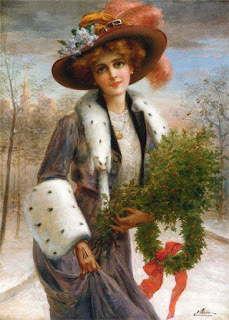 Vernon, Season's Greetings
Susan & Loretta report:
Vernon, Season's Greetings
Susan & Loretta report:‘Tis the season—and with suitably jolly and joyful spirits, the Two Nerdy History Girls are going to take our annual holiday break, to spend more time with our families and less time on social media. We may pop into the blog now and again with a picture or two and maybe a few words, but regularly scheduled blogging will not resume until 2018.
We thank you for continuing to share our historical enthusiasms, for encouraging us to continue, and for reading our books as well. They’re the reason we started blogging in the first place: all those bits of historical reality that wouldn’t fit neatly into our fiction but we just had to share. How lucky we are to have found so many like-minded readers!
Dear Readers, we wish you a very happy holiday season, and a splendid New Year. May it be a bright, healthy, and happy one for all of you.
Image: Émile Vernon, Season’s Greetings, courtesy Wikipedia
Clicking on the image will enlarge it. Clicking on the caption will take you to the source, where you can learn more and enlarge images as needed.
Published on December 19, 2017 21:30
December 18, 2017
From the Archives: The Unsupervised Tailor's Apprentice & the Christmas Coat for a Cat, c. 1775
 Susan reporting,
Susan reporting,Most memoirs written by veterans of the Revolutionary War concentrate on glorious battles won, comrades lost, and patriotic fervor, and the memoirs of James Potter Collins (1763-1844) are no different. Born in Tryon County, NC, Collins enlisted in a local militia company at the age of seventeen, and saw action in several of the most important battles of the southern campaigns. But Collins's memoirs also include this entertaining anecdote from his days as a twelve-year-old tailor's apprentice with a bit too much unsupervised time.
"I had been at work about two months when Christmas came on – and here I must relate a little anecdote. The principal [the tailor] and his lady were invited to a party among their friends...while it devolved on me to stay at home and keep house. There was nothing left me in charge to do, only to take care of the house. There was a large cat that generally lay about the fire. In order to try my mechanical powers, I concluded to make a suit of clothing for puss, and for my purpose gathered some scraps of cloth that lay about the shop-board, and went to work as hard as I could. Late in the evening I got my suit of clothes finished; I caught the cat, put on the whole suit – coat, vest, and small-clothes [breeches] – buttoned all on tight, and set down my cat to inspect the fit.
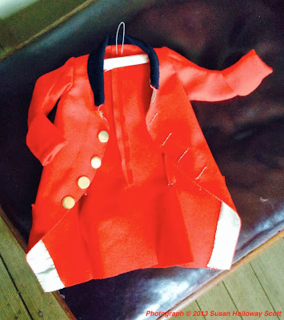
"Unfortunately for me there was a hole through the floor close to the fireplace, just large enough for the cat to pass down; after making some efforts to get rid of the clothes, and failing, pussy descended through the hole and disappeared; the floor was tight and the house underpinned with brick, so there was no chance of pursuit. I consoled myself with a hope that the cat would extricate itself from its incumbrance, but not so; night came and I had made on a good fire and seated myself for some two or three hours after dark, when who should make their appearance but my master and mistress and two young men, all in good humor, with two or three bottles of rum. After all were seated around the fire, who should appear amongst us but the cat in his uniform. I was struck speechless, the secret was out and had no chance of concealing; the cat was caught, the whole work inspected and the question asked, is this your day's work? I was obliged to answer in the affirmative; I would then have been willing to take a good whipping, and let it stop there, but no, to complete my mortification the clothes were carefully taken off the cat and hung up in the shop for the inspection of all customers that came in."
 –– Autobiography of a Revolutionary Soldier, by James Potter Collins, published 1859
–– Autobiography of a Revolutionary Soldier, by James Potter Collins, published 1859With his own master away from the shop for the holiday, Michael McCarty, above, a tailor's apprentice in the Historic Trades program, Colonial Williamsburg , was inspired to copy Collins' achievement, and make a miniature red hunting coat for his own cat. The coat was made to measure like every 18th c. gentleman's coat would have been, and cut and sewn entirely by hand of fine red woolen, trimmed in black with tiny covered buttons and gold-thread buttonholes. And just like young Collins' cat-coat, Michael's handiwork was on display in the shop window throughout the Christmas season, below left – although someday I'd really like to see it on the cat, too.
Update: I visited Colonial Williamsburg this past weekend, and although the tailors have now moved further down Duke of Gloucester Street to a new shop of their own, I'm happy to report that their holiday decorations still include the little red cat's coat, prominently pinned in the window.
Photographs copyright 2013 by Susan Holloway Scott.
Published on December 18, 2017 21:00
December 17, 2017
Dickens and the Cratchit Family's Christmas Pudding
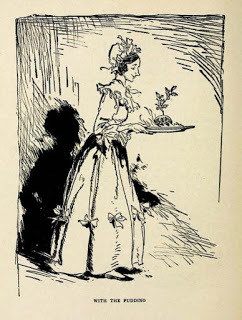 Mrs. Cratchit by Arthur Rackham
Loretta reports:
Mrs. Cratchit by Arthur Rackham
Loretta reports:I haven’t yet seen the movie The Man Who Invented Christmas , but no one needs another movie to associate Charles Dickens with the holiday, thanks to his story, A Christmas Carol .
This past summer, while in London, I spent a few hours touring the Charles Dickens Museum at 48 Doughty Street. Among many items claiming my attention was the kitchen, because we Nerdy History Girls are always curious about everyday life. This house, which reflects the author’s lifestyle when he was just beginning to be famous, is very much a middle-class household, considerably upscale from that of Mr. Scrooge’s clerk, Bob Cratchit.
I offer some images from the kitchen, and leave you to imagine the process of making a Christmas pudding, even in this comfortable household. Then, please imagine what it might have been like for Mrs. Cratchit in her humbler abode. As a museum sign pointed out, “The Cratchit family had only one small pudding, but in a household such as 48 Doughty Street, there were often many spare puddings, cooked and stored for use at other celebrations throughout the year. Filled with spirits, old ale and spices, the puddings were well preserved on larder shelves and were even believed to improve in taste as they aged.”

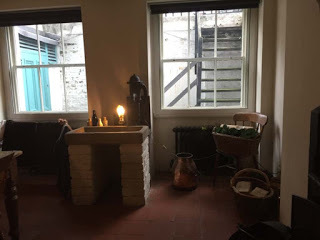 Yes, that's the kitchen sink
Yes, that's the kitchen sinkBut now, the plates being changed by Miss Belinda, Mrs. Cratchit left the room alone—too nervous to bear witnesses— to take the pudding up and bring it in.
Suppose it should not be done enough 1 Suppose it should break in turning out ! Suppose somebody should have got over the wall of the back-yard, and stolen it, while they were merry with the goose—a supposition at which the two young Cratchits became livid All sorts of horrors were supposed.
Hallo! A great deal of steam. The pudding was out of the copper. A smell like a washing-day! That was the cloth. A smell like an eating-house and a pastrycook's next door to each other, with a laundress's next door to that! That was the pudding ! In half a minute Mrs. Cratchit entered—flushed, but smiling proudly —with the pudding, like a speckled cannon-ball, so hard and firm, blazing in half of half-a-quartern of ignited brandy, and bedight with Christmas holly stuck into the top.
Oh, a wonderful pudding ! Bob Cratchit said, and calmly too, that he regarded it as the greatest success achieved by Mrs. Cratchit since their marriage. Mrs. Cratchit said that now the weight was off her mind, she would confess she had had her doubts about the quantity of flour. Everybody had something to say about it, but nobody said or thought it was at all a small pudding for a large family. It would have been flat heresy to do so. Any Cratchit would have blushed to hint at such a thing. At last the dinner was all done, the cloth was cleared, the hearth swept, and the fire made up.
—“A Christmas Carol,” from The Works of Charles Dickens, Volume 13
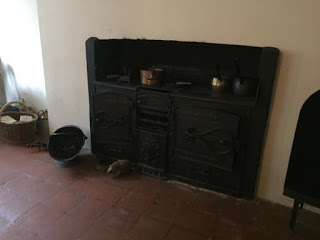 Hedgehogs used for insect controlPhotos of Charles Dickens Museum copyright © Loretta Chekani 2017
Hedgehogs used for insect controlPhotos of Charles Dickens Museum copyright © Loretta Chekani 2017Illustration of Mrs. Cratchit carrying in the pudding by Arthur Rackham for 1915 edition.
Please click on images to enlarge.
Published on December 17, 2017 21:30
December 14, 2017
Friday Video: A Victorian Christmas & Victorian Dolls
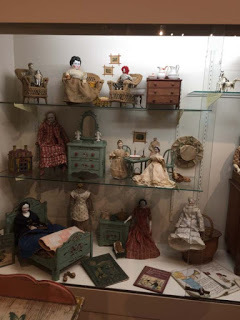 Loretta reports:
Loretta reports:Looking for some holiday-type historical footage for the Friday video, I came upon these stereoscopic images of staged, late-Victorian Christmas celebrations. Many of the images seem a little eerie to me. But then, Victorian images often are. In this case, too, the the strange “animation,” combined with the stereoscopic effect, heightens the sensation.
But I was struck by the little girls cradling their dolls, an image that remains familiar and sweet.
Then I remembered the photos of Victorian toys—mainly dolls and doll furniture—I took in September at the Provincetown Museum , which is part of the Pilgrim Monument .* I could picture little girls on Christmas morning, lovingly holding these dolls when they were new.
*No, I didn’t climb to the top of the monument. There’s quite a lovely panoramic view on the website .
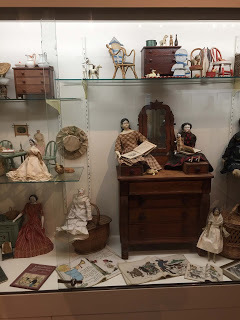
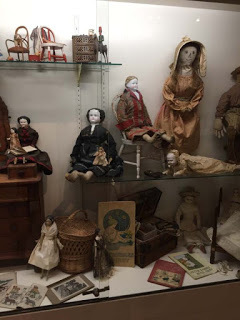
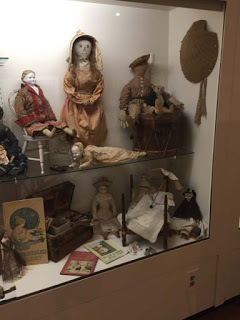
Video: 3D Stereoscopic Photographs of Christmas in the Victorian Era (1889-1902)
Readers who receive our blog via email might see a rectangle, square, or nothing where the video ought to be. To watch the video, please click on the title to this post. Please click on images to enlarge.
Published on December 14, 2017 21:30
December 13, 2017
From the Archives: Mistletoe Madness, 1796
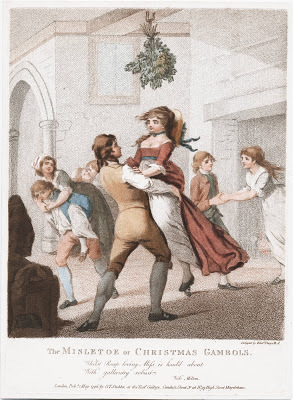 Susan reporting:
Susan reporting:In modern holiday celebrations, mistletoe has become something of a kitsch-y joke, the inevitable prop for I Saw Mommy Kissing Santa Claus humor.
But in the 1790s, when the print, left, was published, mistletoe still had an aura of wickedness, even danger. The ancient Druidic traditions linking mistletoe and fertility had not been forgotten, and kissing beneath the mistletoe was thought to lead to promiscuity, or even - shudder! - marriage.
Certainly the four merry young couples in this print appear to be enjoying themselves. Some scholarly descriptions refer to this as a dance scene, and perhaps it does show nothing more than a particularly rollicking country dance.
Still, I can't help but think that at any moment some stern-faced, indignant elder is going to appear in the doorway and demand to know what exactly is going on down here. I'm guessing the artist thought that, too, from the caption he added to the bottom: "Whilst Romp loving Miss is haul'd about/With gallantry robust." (The attribution to Milton is incorrect; the line is from a poem by the 18th c. Scottish poet James Thomson.) In any event, there's no doubt that these are romp-loving misses being haul'd about by their robust gallants. No wonder Christmas mistletoe was so popular!
Above: The mistletoe, or, Christmas gambols, by Edward Penny, 1796, London. Lewis Walpole Library, Yale University.
Published on December 13, 2017 21:00
December 11, 2017
The White Lion Inn, Putney
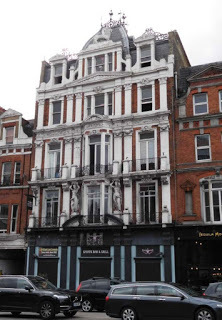 Loretta reports:
Loretta reports:Most of the locations in A Duke in Shining Armor are real—or as real as I can make them. Some once existed but no longer do, some have changed beyond recognition, and some are there, looking more or less the same. None are quite the same, of course. For one thing, the extant buildings have indoor plumbing. And electricity.
The White Lion Inn, where several important early scenes occur, did and does exist, although my characters wouldn’t recognize it today, and may not have even known it by that name.
What I saw, when studying my copy of the Panorama of the Thames , was the Putney Hotel, which a note in the text referred to as the Red Lion Inn. But it seems to be the same building Ralph Rylance refers to in his 1815 guidebook, The Epicure’s Almanack , as the White Lion. (More about the book here , here , and here .)
White Lion.“Continuing on your way to town you come to the village of Putney, at the bottom of which, close to the Fulham Bridge, is the White Lion.[2] You may have a good dinner drest here to order, in which order you ought not to forget to include stewed eels, or fried flounders. The people here have a live stock of them in the wells of the peter-boats moored off the village.”The footnote explains further:
[2] “The White Lion near Fulham Bridge (now Putney Bridge) dated from the early C17 and was rebuilt in 1887; it is still operating, as the ‘Australian Walkabout Inn,’ at nos. 14-16 Putney High Street.” (p. 203)
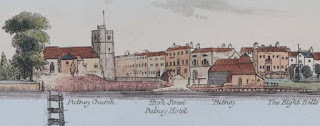 View of Putney in 1829
View of Putney in 1829
On my investigatory tour of Putney, last summer, we came upon what seemed to be the right building. At the time, though, I wasn’t sure this was the place, because it looked like a late Victorian era structure, and closer inspection confirmed an 1880s date. Still, the big lion on top was a clue, and I asked Walter to take some photos. Once home, with various books at hand, I felt more certain of its identity. This did seem to be the White Lion, extensively renovated and decorated or maybe entirely rebuilt. I can also confirm that it (1) is no longer the Australian Walkabout Inn, (2) was closed, and (3) had been closed for some time. But everything about its location did fit my mental images for the story. Obviously, for the interior and stable yard scenes, I had to use a combination of imagination and research into 18th and 19th century coaching inns.
Photograph at top by Walter M. Henritze, III. The image of 1829 Putney is a screen shot from the fabulous website connected with the Panorama of the Thames , a gorgeous book. I strongly recommend your visiting the website, for larger images, and tons of information. You can scroll along for the river view or search by specific locations.
More images of the White Lion here at the Victorian Web and here at Wikimedia Commons .
Clicking on the image will enlarge it. Clicking on the caption will take you to the source, where you can learn more and enlarge images as needed.
Published on December 11, 2017 21:30
December 10, 2017
George Washington's Diamond Eagle, 1784
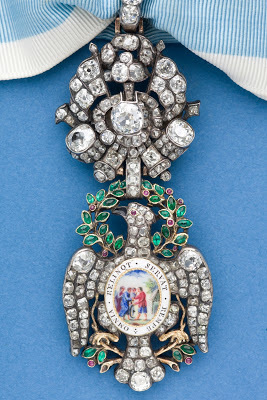 Susan reporting,
Susan reporting,George Washington - commander-in-chief of the Continental Army during the American Revolution and the first President of the United States - was the most painted American of the 18thc. In all those many portraits, he is shown either in his general's uniform of buff and blue, or in civilian clothes, often a black suit. Compared to his counterparts in Europe, his dress is sober, even severe, as was fitting for a near-legendary citizen-soldier, the leader of a new republic.
However, in the case of this remarkable jewel-encrusted medal - which doesn't appear in any of those portraits of Washington - the general made an exception.
After the end of the war, officers of the Continental Army and their French counterparts who had served together formed the Society of Cincinnati. The mission of the Society was to preserve the memory of the war for future generations, and to maintain an appreciation for the achievement of American independence.
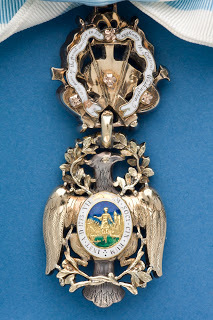
The golden eagle that became the Society's insignia was designed by Pierre Charles L'Enfant, the French-born military engineer who served in the Revolution and, in time, became the master planner of Washington, DC. When L'Enfant returned to France to have the Eagle made by the Parisian goldsmiths, officers of the French Navy commissioned a more impressive, jeweled version as a surprise for Washington - the Diamond Eagle shown here. L'Enfant carried the medal back to America with him in 1784, and presented it to Washington on behalf of the French officers at the first general meeting of the Society of Cincinnati in Philadelphia in May, 1784.
Washington seemed to have reserved the Diamond Eagle for the most formal occasions. As President General of the Society of Cincinnati, he likely wore it for the Society's special events, and also for his own annual birthday ball. Featuring emeralds, rubies, and 160 diamonds from India and Brazil and a total diamond weight of 9 cts., the medal also includes scenes and mottoes related to the life of Cincinnatus, the self-sacrificing Roman statesman to whom Washington was often compared. The medal was unique in 18thc America, and was a stunning tribute to the man who wore it.
After Washington's death, his widow Martha Washington sent the Diamond Eagle to Alexander Hamilton, the newly-elected President General of the Society. Following Hamilton's death in 1804, his widow Elizabeth Hamilton (yes, the heroine of my historical novel I, ELIZA HAMILTON ) sent the medal to the third President General, Charles Cotesworth Pinckney. Pinckney in turn donated the Diamond Eagle to the Society in 1811, and it became the badge of office of the president general of the Society. The Society continues today as the oldest patriotic organization in America, and remains devoted to the principles and ideals of its founders.
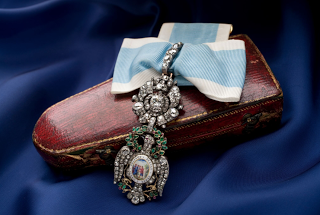
Rarely exhibited publicly, the Diamond Eagle is currently on loan to the Museum of the American Revolution in Philadelphia until March 3, 2018. It's especially fitting that the medal is displayed in the museum adjacent to Washington's War Tent, another powerful symbol of Washington's dedication to his troops and the Revolution.
See here for more information about viewing the Diamond Eagle at the MoAR.
Above: The Diamond Eagle, front and back, with its original leather case. The blue and white ribbon, symbolizing the continuing friendship between France and the United States, is a modern replacement. All photographs courtesy of the Society of Cincinnati.
Published on December 10, 2017 18:52
December 9, 2017
Breakfast Links: Week of December 4, 2017
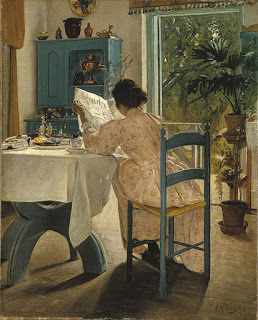 Breakfast Links are served - our weekly round-up of fav links to other web sites, articles, blogs, and images via Twitter.
Breakfast Links are served - our weekly round-up of fav links to other web sites, articles, blogs, and images via Twitter.• Henrietta Duterte, the first black female funeral director, who used coffins to help people escape slavery.
• During World War One, patriotic knitters faced the perils of "knitter's face" and "knitting nerves."
• Anne of Green Gables , patron saint of girls who ask too many questions.
• Image: Shopping, 1787: Gallerie du Palais Royal, Paris.
• The true history of Pocahontas : romantic historical myths versus tragic reality.
• Frost fairs on the Thames .
• "I heard the bells on Christmas Day": how hope rose from despair for poet Henry Wadsworth Longfellow .
• Now online: Horwood's Plan of the Cities of London , 1792-99, puts the city (even houses!) at your fingertips.
• The scandalous and formidable Lady Holland .
• Image: Fine glass kohl pot from ancient Egypt retains its original applicator, much like modern mascara.
• The hidden history of mac and cheese .
• The politics of hair .
• Thousands of women pursued their own California dreams during World War Two.
• Murder ballads , gender, and who deserves to die.
• The splendor of weddings during the Italian Renaissance.
• Image: A 19thc letter written in cross-hatching to save postage and paper.
• Lace me up, Daddy: a brief glimpse into male corsetry.
• How Victorian women cleaned their fancy dresses.
• Was Lydia E. Pinkham the Queen of Quackery?
• The mysterious New Orleans chapel of prosthetic limbs .
• Image: Proof that none of us have risen to the modern challenge of serving pasta elegantly.
Hungry for more? Follow us on Twitter @2nerdyhistgirls for fresh updates daily.
Above: At Breakfast by Laurits Andersen Ring. Private collection
Published on December 09, 2017 14:00



